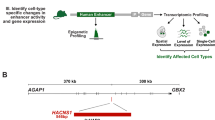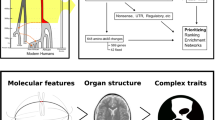Abstract
Humans differ from other animals in many aspects of anatomy, physiology, and behaviour; however, the genotypic basis of most human-specific traits remains unknown1. Recent whole-genome comparisons have made it possible to identify genes with elevated rates of amino acid change or divergent expression in humans, and non-coding sequences with accelerated base pair changes2,3,4,5. Regulatory alterations may be particularly likely to produce phenotypic effects while preserving viability, and are known to underlie interesting evolutionary differences in other species6,7,8. Here we identify molecular events particularly likely to produce significant regulatory changes in humans: complete deletion of sequences otherwise highly conserved between chimpanzees and other mammals. We confirm 510 such deletions in humans, which fall almost exclusively in non-coding regions and are enriched near genes involved in steroid hormone signalling and neural function. One deletion removes a sensory vibrissae and penile spine enhancer from the human androgen receptor (AR) gene, a molecular change correlated with anatomical loss of androgen-dependent sensory vibrissae and penile spines in the human lineage9,10. Another deletion removes a forebrain subventricular zone enhancer near the tumour suppressor gene growth arrest and DNA-damage-inducible, gamma (GADD45G)11,12, a loss correlated with expansion of specific brain regions in humans. Deletions of tissue-specific enhancers may thus accompany both loss and gain traits in the human lineage, and provide specific examples of the kinds of regulatory alterations6,7,8 and inactivation events13 long proposed to have an important role in human evolutionary divergence.
This is a preview of subscription content, access via your institution
Access options
Subscribe to this journal
Receive 51 print issues and online access
$199.00 per year
only $3.90 per issue
Buy this article
- Purchase on Springer Link
- Instant access to full article PDF
Prices may be subject to local taxes which are calculated during checkout



Similar content being viewed by others
References
Varki, A. & Altheide, T. Comparing the human and chimpanzee genomes: searching for needles in a haystack. Genome Res. 15, 1746–1758 (2005)
Bustamante, C. D. et al. Natural selection on protein-coding genes in the human genome. Nature 437, 1153–1157 (2005)
Khaitovich, P. et al. Parallel patterns of evolution in the genomes and transcriptomes of humans and chimpanzees. Science 309, 1850–1854 (2005)
Pollard, K. S. et al. An RNA gene expressed during cortical development evolved rapidly in humans. Nature 443, 167–172 (2006)
Prabhakar, S. et al. Human-specific gain of function in a developmental enhancer. Science 321, 1346–1350 (2008)
King, M. C. & Wilson, A. C. Evolution at two levels in humans and chimpanzees. Science 188, 107–116 (1975)
Carroll, S. B. Evo-devo and an expanding evolutionary synthesis: a genetic theory of morphological evolution. Cell 134, 25–36 (2008)
Chan, Y. F. et al. Adaptive evolution of pelvic reduction in sticklebacks by recurrent deletion of a Pitx1 enhancer. Science 327, 302–305 (2010)
Muchlinski, M. N. A comparative analysis of vibrissa count and infraorbital foramen area in primates and other mammals. J. Hum. Evol. 58, 447–473 (2010)
Hill, W. C. O. Note on the male external genitalia of the chimpanzee. Proc. Zool. Soc. Lond. 116, 129–132 (1946)
Zerbini, L. F. et al. NF-κB-mediated repression of growth arrest- and DNA-damage-inducible proteins 45α and γ is essential for cancer cell survival. Proc. Natl Acad. Sci. USA 101, 13618–13623 (2004)
Zhang, X. et al. Loss of expression of GADD45γ, a growth inhibitory gene, in human pituitary adenomas: implications for tumorigenesis. J. Clin. Endocrinol. Metab. 87, 1262–1267 (2002)
Olson, M. When less is more: gene loss as an engine of evolutionary change. Am. J. Hum. Genet. 64, 18–23 (1999)
The Chimpanzee Sequencing and Analysis Consortium . Initial sequence of the chimpanzee genome and comparison with the human genome. Nature 437, 69–87 (2005)
Green, R. E. et al. A draft sequence of the Neandertal genome. Science 328, 710–722 (2010)
Duret, L. & Galtier, N. Biased gene conversion and the evolution of mammalian genomic landscapes. Annu. Rev. Genomics Hum. Genet. 10, 285–311 (2009)
Chou, H. H. et al. A mutation in human CMP-sialic acid hydroxylase occurred after the Homo-Pan divergence. Proc. Natl Acad. Sci. USA 95, 11751–11756 (1998)
Visel, A. et al. ChIP-seq accurately predicts tissue-specific activity of enhancers. Nature 457, 854–858 (2009)
McLean, C. Y. et al. GREAT improves functional interpretation of cis-regulatory regions. Nature Biotechnol. 28, 495–501 (2010)
Dixson, A. F. Primate Sexuality (Oxford University Press, 1998)
Lovejoy, C. O. Reexamining human origins in light of Ardipithecus ramidus . Science 326, 74e1–74e8 (2009)
Crocoll, A., Zhu, C. C., Cato, A. C. & Blum, M. Expression of androgen receptor mRNA during mouse embryogenesis. Mech. Dev. 72, 175–178 (1998)
Ibrahim, L. & Wright, E. A. Effect of castration and testosterone propionate on mouse vibrissae. Br. J. Dermatol. 108, 321–326 (1983)
Dixson, A. F. Effects of testosterone on the sternal cutaneous glands and genitalia of the male greater galago (Galago crassicaudatus crassicaudatus). Folia Primatol. (Basel) 26, 207–213 (1976)
Murakami, R. A histological study of the development of the penis of wild-type and androgen-insensitive mice. J. Anat. 153, 223–231 (1987)
Gohlke, J. M. et al. Characterization of the proneural gene regulatory network during mouse telencephalon development. BMC Biol. 6, 15 (2008)
Gelman, D. M. et al. The embryonic preoptic area is a novel source of cortical GABAergic interneurons. J. Neurosci. 29, 9380–9389 (2009)
Vue, T. Y. et al. Characterization of progenitor domains in the developing mouse thalamus. J. Comp. Neurol. 505, 73–91 (2007)
Arcelli, P., Frassoni, C., Regondi, M. C., De Biasi, S. & Spreafico, R. GABAergic neurons in mammalian thalamus: a marker of thalamic complexity? Brain Res. Bull. 42, 27–37 (1997)
Kriegstein, A., Noctor, S. & Martínez-Cerdeño, V. Patterns of neural stem and progenitor cell division may underlie evolutionary cortical expansion. Nature Rev. Neurosci. 7, 883–890 (2006)
Acknowledgements
We thank D. DeGusta for providing chimpanzee DNA, S. McConnell and P. Buckmaster for discussions, and M. Hiller and C. Barr for ontology analysis support. This work was supported in part by a Bio-X graduate fellowship (C.Y.M.), a Ruth L. Kirschstein NRSA post-doctoral fellowship (1 F32 HD062137-01, P.L.R.), a National Defense Science and Engineering Graduate fellowship (A.A.P.), a National Science Scholarship of the Agency of Science, Technology, and Research, Singapore (X.L.), a Stanford Graduate Fellowship (A.M.W.), an Edward Mallinckrodt, Jr. Foundation grant (G.B.), and National Institute of Health grants R01 HD059862 (G.B.), R01 HG005058 (G.B.) and P50 HG002568 (D.M.K.). G.B. is a Packard Fellow, Searle Scholar, Microsoft Faculty Fellow and an Alfred P. Sloan Fellow. D.M.K. is an investigator of the Howard Hughes Medical Institute.
Author information
Authors and Affiliations
Contributions
G.B. and D.M.K. conceived the investigation; C.Y.M. performed the computational analyses; P.L.R, A.A.P., A.I.B., T.D.C, C.G., V.B.I., X.L., D.B.M. and B.T.S. performed the experiments; C.Y.M., P.L.R., A.A.P, B.T.S, A.M.W., G.B. and D.M.K. analysed the data; and C.Y.M., P.L.R., A.A.P., G.B. and D.M.K. wrote the paper with contributions from all authors.
Corresponding authors
Ethics declarations
Competing interests
The authors declare no competing financial interests.
Supplementary information
Supplementary Information
This file contains Supplementary Materials and Methods, Supplementary Figures 1-10 with Legends, Supplementary Tables 1 and 3-12 (see separate file for Supplementary Table 2) and additional references. (PDF 1075 kb)
Supplementary Table 2
This file is an annotated spreadsheet providing access to all 583 hCONDELs, 344 cCONDELs, and 350 mCONDELs. (XLS 853 kb)
Rights and permissions
About this article
Cite this article
McLean, C., Reno, P., Pollen, A. et al. Human-specific loss of regulatory DNA and the evolution of human-specific traits. Nature 471, 216–219 (2011). https://doi.org/10.1038/nature09774
Received:
Accepted:
Published:
Issue Date:
DOI: https://doi.org/10.1038/nature09774
This article is cited by
-
Genetics of human brain development
Nature Reviews Genetics (2024)
-
Epigenetic regulation of human-specific gene expression in the prefrontal cortex
BMC Biology (2023)
-
Evolutionary relevance of single nucleotide variants within the forebrain exclusive human accelerated enhancer regions
BMC Molecular and Cell Biology (2023)
-
Human-specific genetics: new tools to explore the molecular and cellular basis of human evolution
Nature Reviews Genetics (2023)
-
Evolutionary dynamics of genome size and content during the adaptive radiation of Heliconiini butterflies
Nature Communications (2023)
Comments
By submitting a comment you agree to abide by our Terms and Community Guidelines. If you find something abusive or that does not comply with our terms or guidelines please flag it as inappropriate.



